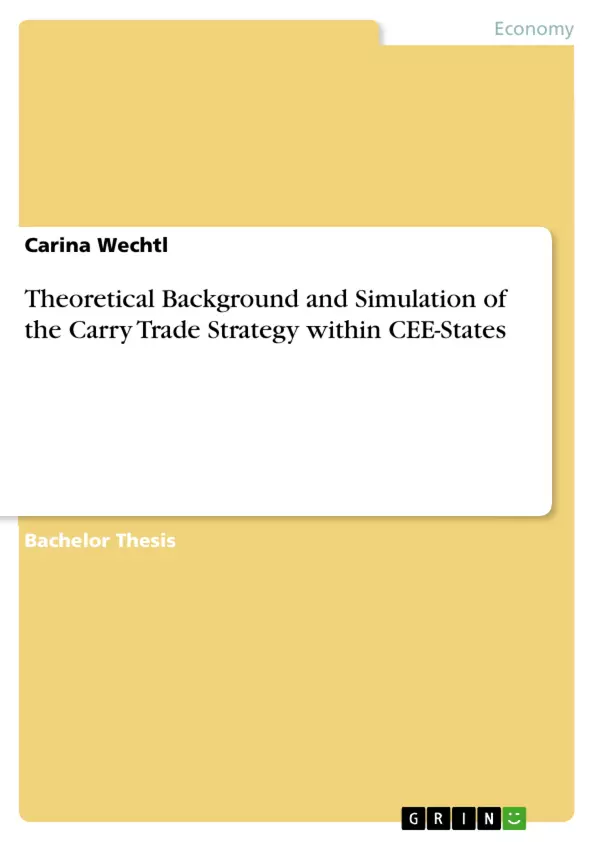Research question:
The main research question: "How does the carry trade strategy work?" is focused on a basic explanation of the carry trade strategy. This question is answered in chapter four including the risk and profitability of carry trades.
The sub-question is: "What is the theoretical background?" This question is focused in chapter two, chapter three and the beginning of chapter four. Chapter seven summarizes this paper and gives the answer if someone should invest money by using this strategy.
Inhaltsverzeichnis (Table of Contents)
- Problem outline and significance
- Purpose and Motivation
- Research question
- Methodology
- Disposition
- Terminology
- Foreign Exchange Markets
- Characteristics of the Foreign Exchange Market
- Efficient Market Hypotheses
- International Parity Relationships
- Parities
- Interest Rate Parity
- Purchasing Power Parity
- Unbiased Forward Rate
- Fisher Effect
- International Fisher Effect
- Carry Trade Strategy
- Forward Premium Puzzle
- Explanation of the Carry Trade Strategy
- Risk and Profitability of the Carry Trade Strategy
- Data set and explanation of the case study
- Assumptions
- Foreign Exchange Rate
- Money Market Rate
- Spread Sheet for Carry Trade Strategy and its Results
- Fundamental law of Active Management
- Active Return
- Active Risk
- Information Ratio
- Conclusion and critical acclaim
Zielsetzung und Themenschwerpunkte (Objectives and Key Themes)
This seminar paper investigates the theoretical background and practical application of the carry trade strategy within Central and Eastern European (CEE) states. It aims to explore the potential for profit generation through this strategy by leveraging interest rate differentials and analyzing its risk profile.
- Foreign exchange markets and their characteristics
- International parity relationships and their implications
- Carry trade strategy and its underlying mechanisms
- Risk and profitability analysis of the carry trade strategy
- Application of the carry trade strategy in a case study setting
Zusammenfassung der Kapitel (Chapter Summaries)
- Problem outline and significance: This chapter introduces the topic of the seminar paper, outlining its purpose, motivation, and research question. It also defines the methodology, disposition, and key terminology used throughout the paper.
- Foreign Exchange Markets: This chapter delves into the characteristics of foreign exchange markets, emphasizing their significance in the global financial system. It explores the concept of efficient market hypotheses and their implications for exchange rate movements.
- International Parity Relationships: This chapter analyzes the key parity relationships that govern international financial markets. It examines concepts such as interest rate parity, purchasing power parity, unbiased forward rate, and Fisher effect.
- Carry Trade Strategy: This chapter focuses on the carry trade strategy, exploring its rationale and potential benefits. It discusses the forward premium puzzle and examines the risks and profitability associated with this investment approach.
- Data set and explanation of the case study: This chapter presents the data set used for the case study and outlines the assumptions underpinning the analysis. It examines the foreign exchange rate and money market rate data utilized in the study and explains the spreadsheet used for carrying out the carry trade strategy simulation.
- Fundamental law of Active Management: This chapter examines the key principles of active management, including active return, active risk, and information ratio. It provides a theoretical framework for understanding the performance evaluation of investment strategies.
Schlüsselwörter (Keywords)
The seminar paper focuses on the carry trade strategy within Central and Eastern European (CEE) states, analyzing its theoretical underpinnings and empirical application. Key terms include foreign exchange markets, interest rate parity, purchasing power parity, forward premium puzzle, active management, and risk and profitability analysis. This paper aims to provide insights into the potential of this investment strategy for investors operating in the CEE region.
- Quote paper
- Mag.(FH) Carina Wechtl (Author), 2011, Theoretical Background and Simulation of the Carry Trade Strategy within CEE-States, Munich, GRIN Verlag, https://www.grin.com/document/186779



